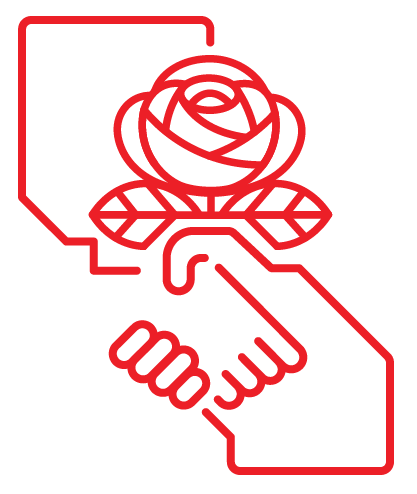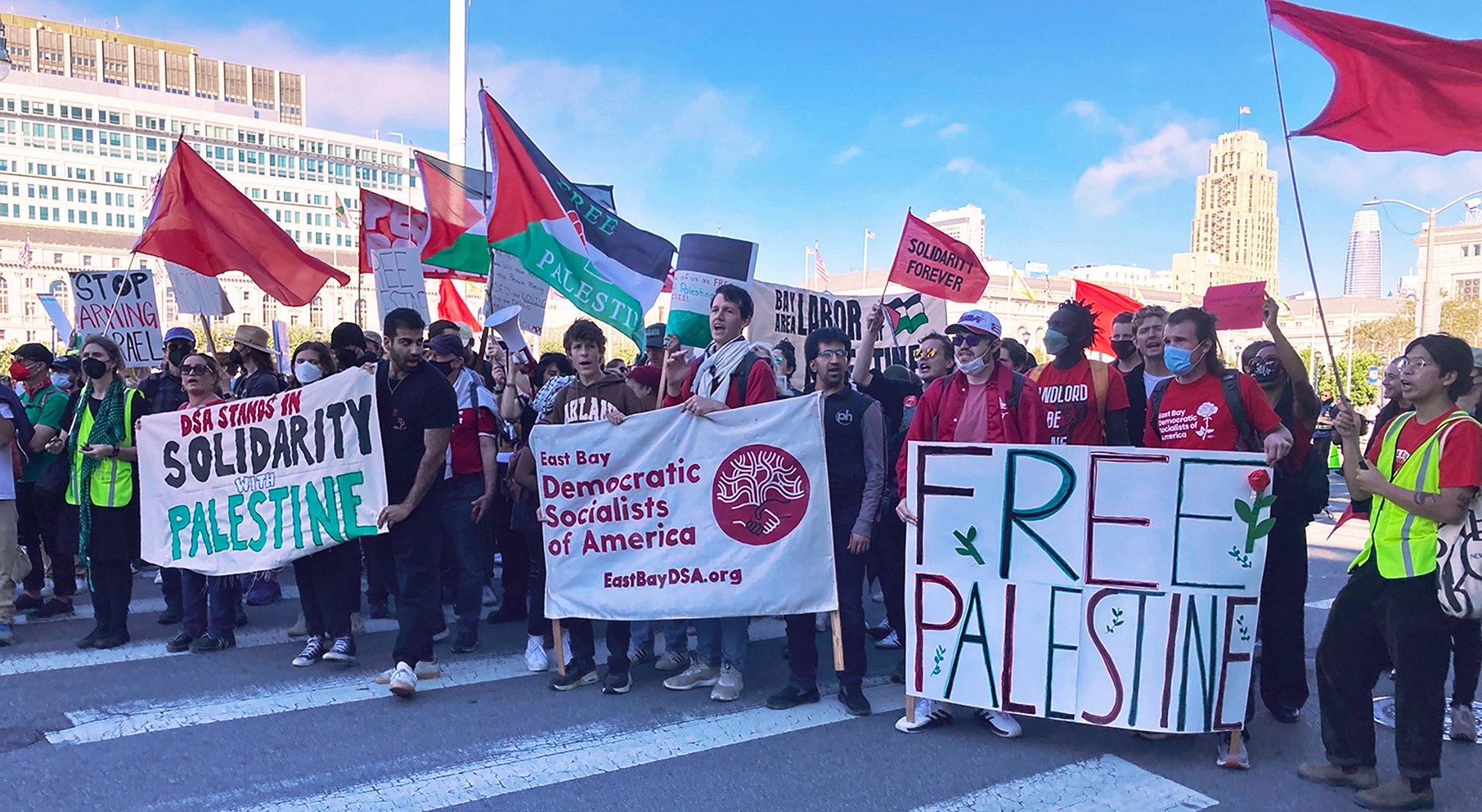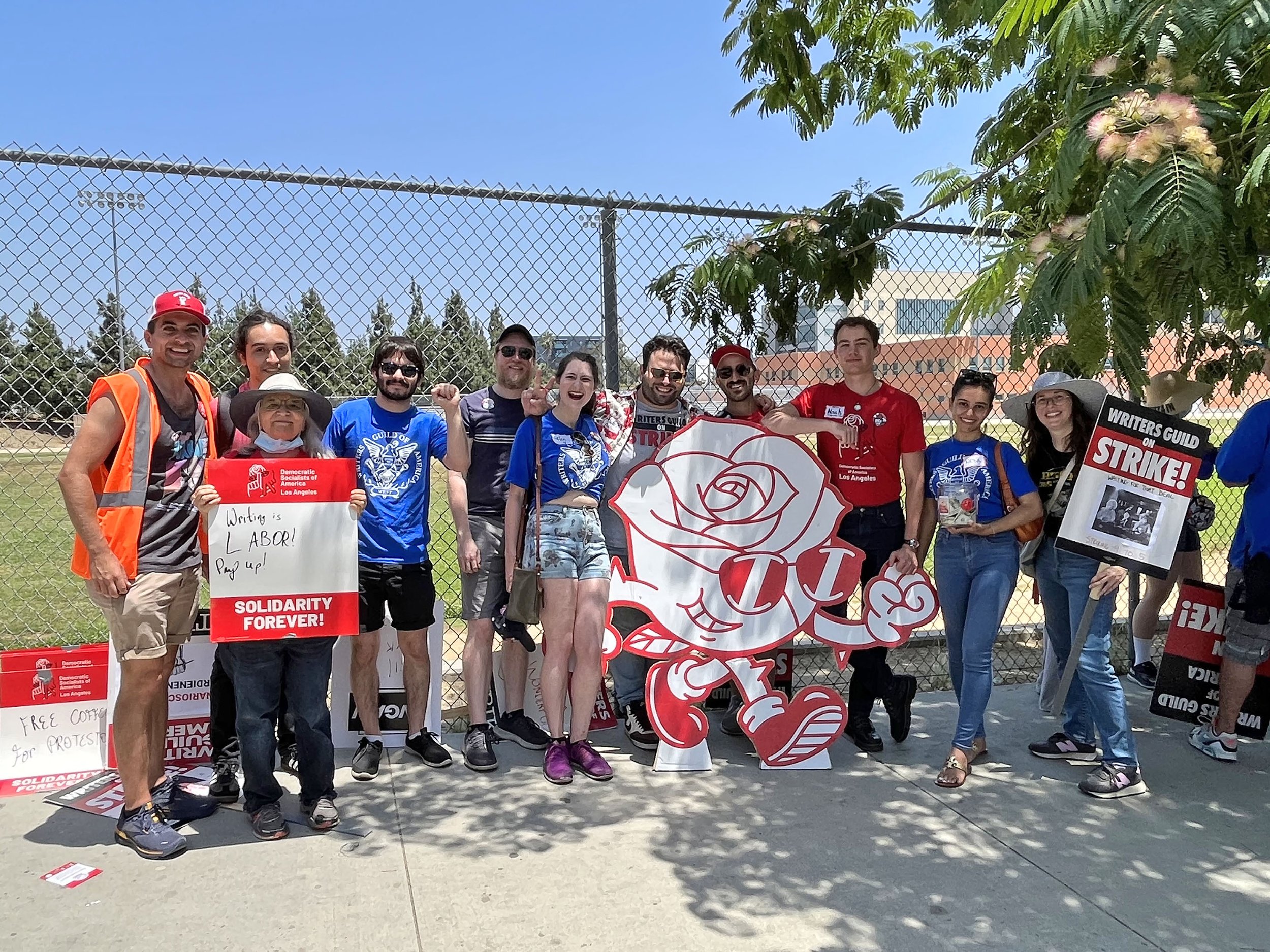California DSA and Labor: The Year in Review
It’s been quite a year for the fledgling (founded in early 2022) California DSA. That’s because it’s been quite a year for the multiracial working class, which has supported a flood of successful union contract campaigns, largely due to a spectacular wave of powerful strikes, alongside a brand-new anti-war movement representing a cross-section of the left. California DSA members have been involved with all these activities and more—and California Red, your bimonthly socialist newsletter, launched on Mayday of this year, has been covering as much of them as we can.
The Events
Although 2023 is technically the year we speak of, it began thematically with the emblematic UC academic worker strike in late 2022. More California DSA members participated directly in this strike than any in history (admittedly the history of California DSA only goes back to February of 2022, but still.) We don’t have a precise count. Nonetheless it’s safe to say hundreds of DSA members took part, including the president of UAW 2865. And the strike, with 48,000 workers walking the lines, was the biggest in academic labor history, and so successful that it inspired a spate of copycat strikes around the country.
It didn’t take long for the next big one: SEIU 99, representing classified workers in Los Angeles Unified School District, struck for three days in March, winning a 30% raise for the lowest paid workers. The secret ingredient to the union’s success? Full on solidarity from United Teachers Los Angeles, who left their classrooms to honor the picket lines of their support workers. The enormous numbers in the streets and popular support from parents and students demonstrated to a chastised administration that it would be best to settle with UTLA as well, which, without the need for its own walkout, negotiated a strong contract on the basis of its obvious ability to mobilize its members. Dozens of dual DSA/UTLA members played a strong role in the actions leading up to the contract settlement.
Soon enough these public sector unions were followed by their siblings in private industry. As a third of a million UPS workers represented by the International Brotherhood of Teamsters across the country prepared to hit the bricks, with demonstrations and “practice strikes” following a 97% strike vote, DSA chapters sent members to join them via a Strike Ready campaign. As with UTLA, UPS workers didn’t have to strike due to their evident readiness to do it. At the last minute of an extension on the first strike deadline the union and corporation reached a deal. Despite arguments over whether UPS workers could have gotten an even better contract if they had struck, everyone agreed that the contract was the best since the 1997 strike, bringing up the least paid workers and gaining important health and safety improvements.
In Hollywood, the Writers Guild of America and SAG/AFTRA, representing 175,000 writers and actors, did have to strike against the arrogant movie studio bosses, and these were long ones, with WGA out on the lines for 148 days and the actors for 118. Determined to gain pioneering protections against potential damage to their livelihoods from advancing artificial intelligence, and make up for years of inflation eroding wages, movie workers received unprecedented solidarity as they outlasted the wealthy and powerful movie studios. Dual DSA-LA/UTLA members helped to organize a big turnout of UTLA to the WGA lines in June, and the LA chapter, with its innovative “Snacklist” deliveries, raised $87,000 worth of food by the end of September, earning a shoutout in WGA publications. And movie workers returned to the sets with strong wage gains and a solid foot in the door on AI.
Overlapping with the Hollywood strikes were rolling strikes by hotel, restaurant and casino workers in UNITE HERE-represented workplaces in LA, Las Vegas and Detroit. The largest health care worker strike ever erupted in October for three days with 75,000 members of a Kaiser union coalition in four states walking out.
The big enchilada
But the big enchilada was the United Auto Workers “Standup” strike starting September 15 against the Big 3 carmakers in the union’s traditional jurisdiction. Shawn Fain, elected in spring with a rank-and-file caucus majority to control the international executive board, had promised that these negotiations would be different, and he was as good as his word. Replacing the traditional class collaborationist approach of his corrupt predecessors with a sharply militant rhetoric and actions to match, he headed up an innovative strategy of striking selected factories owned by all three automakers at once.
Sitting at three negotiations tables, the union punished the companies when bargaining progress stalled by striking additional workplaces; when the companies were demonstrating good faith, no more factories were struck—until progress slowed and more facilities were called out. The picket lines were solid; once more DSA members showed up wherever they could. In California that meant parts suppliers in Ontario and Rancho Cucamonga, where picketers withstood private goon squads, attempts to ram them with cars, and in one instance, a drawn gun.
Following the pattern of other unions’ settlements during the year, when negotiations were concluded at the end of October after the union’s longest strike in a quarter century, auto workers had achieved their best results in decades: a 25% salary increase over the life of the contract (and more for the lowest paid categories of workers), bolstered retirement benefits, and the right to strike over plant closures, among other advances.
More strikes and heightened class consciousness
Over half a million workers have been out on picket lines in 2023. The strike wave shows no sign of abating, with the California Faculty Association, representing full- and part-time professors in the 23-campus California State University system, and IBT, with blue collar workers, shutting down four campuses this month and threatening to shutter more if the administration doesn’t address issues of low pay, two tier salary schedules, and inadequate staffing.
The actions of 2023 have featured heightened solidarity and a new level of class conscious rhetoric out of the mouths of leadership. While top AFL-CIO officers continue, alongside most Democratic politicians, to refer to union members as the aspirational “middle class” of America, leaders of the striking unions have moved on to a more precise vocabulary, and their public pronouncements reflect that understanding. After four decades of neoliberal attacks on wages, unions, government, taxes and regulation of corporations, large sectors of the working class have gained an insight: only their own collective action can reverse the tide.
Shawn Fain exhorted his members to make the connection directly, saying “Let’s stand up for ourselves and for the working class.” Taking a page out of Bernie Sanders’s book, he told the media that billionaires have no right to exist. Teamster leader Sean O’Brien, elected with the support of Teamsters for a Democratic Union, warned during bargaining, “The longer this contract negotiation goes on, the longer Wall Street is going to be affected. And that’s OK, just as long as Main Street gets taken care of at the end of the day.”
Fran Drescher, president of SAG-AFTRA, dispensed with euphemism, telling an interviewer: “I am anti-capitalist”. She also said, “I cannot believe it, quite frankly, how far apart we are on so many things. How they plead poverty, that they’re losing money left and right when giving hundreds of millions of dollars to their CEOs. It is disgusting. Shame on them. They stand on the wrong side of history.”
Where does it go from here?
Since October, alongside the upsurge in labor, a massive anti-war movement has arisen opposing US support for Israeli carpet bombing of Gaza. Large contingents of DSA members have been present at the rallies and marches in California and across the country. Despite national AFL-CIO admonitions for local labor councils to stay out of foreign affairs-related issues, a nascent “Labor4Palestine” effort, also featuring strong DSA involvement, represents a potential further expansion of union political consciousness.
The UAW became the largest national union calling for a permanent ceasefire earlier this month, joining the United Electrical Workers, the Painters, and the American Postal Workers, as well as a growing number of local unions.
No one can predict where things are going; few crystal balls function perfectly in the class struggle. But as Rosa Luxemburg noted in her classic The Mass Strike, political consciousness often lags behind economic consciousness of workers involved in mass actions. Until it doesn’t, when it can take a leap not readily foreseen the previous day.
This question might be posed sharply next year in election season. Currently many young people involved in the Free Palestine struggle are justifiably angry with Joe Biden for continuing to support the US’s massive shipments of arms to Israel; they hold signs at rallies and marches to “dis-elect Biden” and vow to sit out the coming presidential election. On the other hand, if Biden runs (and he shows no sign of not running) and loses, fascism looms. Here we find a contradiction yet to be worked out.
It is the role of socialists, historically and in the present, to help move things to the left within the labor movement. That means militant action, but it also means politics. DSA has shown in the past year its staunch solidarity with the working class in motion. To take things to another level—to build on workplace power as a platform for advancing the political conversation—is not the sole responsibility of DSA. But unless we desire to wake up in November 2024 in a police state, it is necessary to be part of that conversation.













